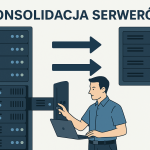
In any company that thrives on IT, where infrastructure resources often grow uncontrollably, server consolidation is becoming not just a trend, but a real need. For many organizations, it’s an opportunity to clean up the environment, reduce costs and increase security – all in one strategic operation. In this article we will explain:
- What is server consolidation,
- How to carry it out step by step,
- Why it pays off – not just financially,
- What benefits it brings to IT security.
What is server consolidation?
Server consolidation is the process of reducing the number of physical servers in an organization by virtualizing them, migrating them to more powerful units, or moving services to the cloud or a professional data center (data center). Instead of a dozen legacy machines, each performing a separate function, an organization can operate on an optimized, centrally managed environment – often based on several strong virtualization hosts or cloud services.
Example:
The company has 2-3 physical servers with different roles – AD, DNS, ERP, backup, database, etc. After analysis, it turns out that many of them are running at low load, and the hardware consumes excessive power and is difficult to maintain. The solution? Consolidate these functions to 1-3 physical machines or migrate to a cloud or hybrid cloud environment.
How to perform server consolidation?
1. audit of the current environment
Start with an inventory: how many servers you have, what functions they perform, their performance, resource consumption, failure rate, system and software versions, maintenance costs.
This is also a great time to assess security – are all servers updated? Are they backed up? Do they have controlled access?
2. cost-effectiveness analysis
Juxtapose the cost of current infrastructure (electricity, cooling, maintenance, warranties, management) with the cost of alternatives:
- Virtualization (e.g., VMware, Proxmox, Hyper-V),
- Cloud migration (Azure, AWS, Jeton Cloud),
- Colocation in a data center (server lease + link + SLA).
3. design of the target environment
Based on the analysis, design a new environment: number of hosts, CPU/RAM/disk requirements, network architecture, security requirements, backup model, remote access, etc.
4 Migration
The process can be carried out in stages:
- Local consolidation first (e.g., several VMs on one server),
- Then migrate to a data center or the cloud,
- Performance tests, transfer of production services.
Why does it pay off?
Financial savings
- Fewer physical machines = lower costs in the cloud or lower power and cooling costs,
- No need to purchase new equipment every 3-5 years,
- Lower licensing costs (fewer operating systems, AV, backup),
- The ability to bill infrastructure as a service (OPEX instead of CAPEX).
- Lower IT maintenance and service costs
Increase productivity
- Modern environments are more responsive,
- Better resource management (automatic CPU/RAM allocation),
- Ability to scale quickly.
Greater security
Consolidation is the perfect time to:
- Implement an update and patching policy,
- Apply network segmentation,
- Centralize backup and monitoring,
- Implement MFA and server access control,
- identify servers with outdated or unauthorized software.
On-premise or cloud?
The decision to stay on-premise, migrate to the cloud or colocate in a data center depends on several factors:
| Criterion | On-Premise | Cloud / Data Center |
|---|---|---|
| Initial costs | High (purchase of equipment) | Low (subscription fee) |
| Scalability | Physically limited | Flexible |
| Physical security | Risk on the part of the company | Professional security features |
| Maintenance | In-house IT department | SLA + external support |
| Energy costs | On the company’s side | On the operator’s side |
Why now?
Many companies are dragging their feet on a “technology legacy” in the form of outdated servers that no one wants to touch anymore. Meanwhile:
- Energy costs are as high as ever,
- Outdated systems pose a cyber security risk,
- Overloaded IT can’t keep up with handling distributed infrastructure,
- Cloud and lease prices are more affordable today than they were a few years ago.
Bottom line – consolidation is not a cost, it’s an investment
Server consolidation is not just a technical reorganization. It’s a strategic move that makes it possible:
- optimize the infrastructure,
- regain control of the IT environment,
- Save tens of thousands of zlotys a year,
- raise the level of safety and reliability.
If your company has not yet conducted such a review – this may be the best time to take care of it. As an MSP company, we help you not only design and implement your environment, but also conduct a solid analysis of profitability and risks.
Have questions or want to see how much you can gain from consolidation? Contact us – we will prepare a free preliminary analysis.







